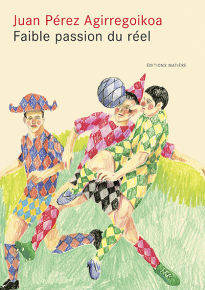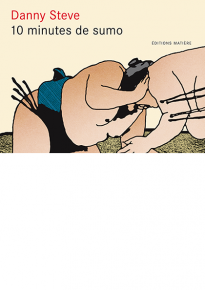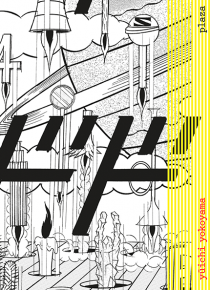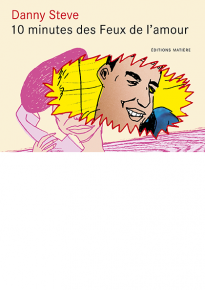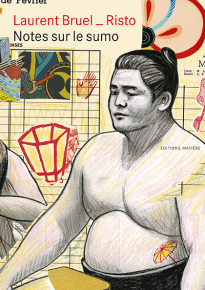RENCONTRE AVEC YUICHI YOKOYAMA, L’INVENTEUR DU MANGA MÉTAPHYSIQUE.
Yûichi Yokoyama est un mangaka hors du commun qui dessine une œuvre fortement marquée par la peinture moderne. Un univers géométrique et inquiétant dans lequel les caractères japonais devenus des éléments du décor créent un véritable fond sonore.
Plasticien ayant délaissé la peinture pour le manga, Yûichi Yokoyama est l’unique représentant d’un genre qu’il a inventé, le néomanga. Expérimentaux et abstraits, ses albums mettent régulièrement en scène des hommes à tête et costumes de robots, circulant, pour des motivations qui restent indéfinies, dans des paysages mécanisés. Les progressions des personnages, les trajets, les avancements de construction tiennent lieu d’intrigue. Yokoyama utilise systématiquement la géométrie, les formes et les structures pour construire ces récits extrêmement formels et malgré tout palpitants. Rencontre avec ce mangaka hors du commun, alors que deux expositions parisiennes, au Palais de Tokyo et à la Galerie Anne Barrault, rendent hommage à son travail.
__
Dans quel environnement avez‑vous grandi ?
Yûichi Yokoyama__ Je suis né dans la préfecture de Miyazaki dans le Kyushu, au sud du Japon. Mais je n’y suis resté que deux mois car mon père était militaire et on a beaucoup déménagé. Les militaires japonais déménagent tous les deux ans, surtout quand ils sont jeunes. En tout j’ai dû déménager 14 fois, dans tout le Japon, Hokkaido, le Kanto, la préfecture de Shizuoka…
__ Est‑ce que l’art et la culture étaient encouragés dans votre famille ?
YY__ Du coté de ma mère, il y a au moins trois professeurs d’art et une autre personne de ma famille dessinait des mangas en quatre cases dans le journal du Kyushu. J’ai aussi un proche qui travaillait dans un musée, donc c’est plutôt beaucoup par rapport à la moyenne ! Mais je n’ai pas eu de mentor particulier. Moi personnellement, l’art et la culture m’intéressaient, mais mon père, ma mère et mon petit frère ne s’y intéressaient pas trop. Enfant, je dessinais mais je ne sais pas si on peut appeler ça des dessins. C’étaient plutôt des graffitis
!
__ Quand avez‑vous décidé que vous feriez carrière dans le dessin ?
YY__ En terminale. Je n’étais pas doué pour les études. Par contre, même avec de mauvais résultats scolaires, on pouvait intégrer les universités d’art. Et je me suis dit que si je devais intégrer une université d’art, autant le faire de façon professionnelle, en faire mon métier. J’ai fait une école préparatoire avant et c’est certainement à ce moment-là que j’ai le plus appris : le dessin, la façon d’utiliser la peinture à l’huile… À l’université je n’ai rien appris, en fait. [
Rires].
__ Que représentaient vos premiers tableaux, qu’aimiez‑vous dessiner ?
YY__ Je suis entré en section de peinture à l’huile et on faisait exclusivement de la peinture à l’huile. Dans les cours, le professeur déposait sur des tables des objets qu’on devait reproduire ou alors un modèle venait prendre la pose. On était obligé de peindre d’après modèle, il n’y avait pas vraiment de liberté, c’était assez rigide. Vers le milieu de mes études à l’université, j’ai commencé à peindre des choses qui me plaisaient, en dehors de ce qu’on devait rendre pour notre cursus. Chez moi, je peignais sans modèle. Je faisais du figuratif. Je pouvais peindre un personnage debout, tout simplement. Je lui mettais le visage que je voulais, l’habillais comme je voulais. Ça m’amusait bien. Mais je n’aurais pas pu montrer ça à mes professeurs, je me serais fait engueuler. Mais jamais je ne me suis dit que j’allais devenir professionnel avec ça. Au contraire, je pensais que ça ne marcherait jamais.
__
Vous intéressiez‑vous à l’art occidental ?
YY__ Oui. J’allais souvent au musée. Comme le cursus où j’étais était très académique, j’allais voir des expositions classiques. Mais à partir d’un certain moment, l’art contemporain m’a beaucoup intéressé. J’aimais le pop art, le minimalisme, le néo
géo, le
new painting. Ces expositions m’étonnaient toujours beaucoup, je me disais qu’il fallait que j’imite ces artistes. Une fois mon diplôme passé, il n’y avait plus personne pour m’engueuler si je dessinais sans modèle, donc j’ai pu les imiter
!
__
Après vos études, vous avez tout de suite gagné votre vie via
la peinture ?
YY__ Non, je n’aurais jamais pu manger
! Pendant dix ans, j’ai fait un travail qui n’avait rien à voir. J’apprenais l’aquarelle à des personnes âgées —
le problème c’est que je ne sais pas faire de l’aquarelle donc j’étais juste présent
! Et ce n’était pas très bien payé.
__
Comment êtes‑vous passé au manga ?
YY__ C’est assez compliqué. Au début je faisais ces imitations d’art contemporain. Je présentais mes œuvres à des concours mais ça ne marchait jamais. À l’époque, j’habitais dans une grande maison pas chère mais très vaste donc je pouvais me permettre de faire des grands formats. Mais j’ai dû la quitter car elle devait être détruite. J’ai déménagé dans une maison plus exiguë et du coup je ne pouvais plus peindre de grands formats. Je me suis dit que j’allais faire la même chose mais sur des petites feuilles de papier. Mais ça perdait en impact. À l’époque, j’ai aussi commencé à recevoir des commandes pour des illustrations et j’y répondais, donc je pouvais quand même gagner ma vie par le dessin. J’ai continué comme ça pendant quelques années. Mais je ne me voyais pas faire ça toute ma vie et comme j’avais déjà eu envie de faire du manga avant, je me suis dit que j’allais me lancer. Et c’est là qu’intervient Laurent Bruel des Éditions Matière. J’avais fait quelques expositions à Tokyo et il a dû en voir une et connaitre mon travail comme ça. Quand il m’a dit «
On va faire un livre
», j’étais extrêmement étonné parce que je n’avais pas eu d’activité de mangaka avant. Au Japon, jamais on ne publierait un inconnu. Et donc je lui suis très reconnaissant.
__
Qu’est‑ce qui vous intéressait dans le fait de dessiner des mangas ? La possibilité de narration ?
YY__ Le fait de dessiner, je ne trouve pas ça amusant du tout, encore aujourd’hui. [
Il dessine un personnage.] Je n’étais jamais satisfait par ce que je dessinais, comme ce bonhomme-là. J’avais envie de dessiner ce qui allait lui arriver après. Est-ce qu’il va marcher quelque part, rencontrer quelqu’un, faire quelque chose
? Je voulais dessiner des scènes. Mais sans couleur, avec un dessin très simple, épuré. Je n’avais pas besoin d’histoire, je voulais juste que ça soit composé de mouvements et de scènes. Ça pouvait commencer n’importe où et se terminer n’importe où. Je voulais représenter des processus en cours.
__
Qualifieriez‑vous vos univers de futuristes ?
YY__ Effectivement, mes mangas ne se passent pas aujourd’hui. Mais je n’ai pas envie de décider que c’est à une époque particulière. Ça peut se passer n’importe quand. Ça peut ne pas être sur la Terre, ça peut être autrefois, ça peut être le futur. C’est ni en Occident, ni en Orient, ni en été ni en hiver. J’aimerais que ce soit un lieu, un temps et un espace qui pourraient s’appliquer partout et nulle part en même temps. C’est comme dans le théâtre nô. Les masques du théâtre nô, avec les yeux en colère et le visage légèrement souriant, sont adaptés à n’importe quelle situation, que le personnage rie ou soit en pleurs… J’essaie de tendre vers ça.
__
Dans vos mangas il y a beaucoup de personnages. Vous dessinez beaucoup de visages, tous inexpressifs mais tous différents. C’est un challenge ?
YY__ J’aime les visages. Chez moi j’ai un stock de visages. Il y a vingt ans je les avais comptés, il y en avait 4
000. Là, je dois en avoir des dizaines de milliers. Quand je fais un manga, je me dis tiens je vais utiliser celui-là, pour cette scène ça sera ce visage-là, etc. C’est un peu comme un casting. Certains n’apparaitront plus mais d’autres peuvent réapparaitre régulièrement.
__
On a l’impression que ces personnages ne ressentent rien. Ils n’ont pas d’émotions ?
YY__ Je ne veux pas que mes histoires parlent d’humains. Je ne veux pas mettre de sentiment. Par exemple, si un insecte ou un oiseau nous regarde, nous humains, cet insecte ou cet oiseau ne va pas se demander quels sont nos sentiments. Je veux qu’on ait le regard d’un insecte face à mes dessins. Autre chose, dans les œuvres au Japon, que ça soit dans la littérature ou le manga, il est tout le temps question de sentiments. Et je déteste ça
!
__
C’est difficile d’interpréter les motivations de vos personnages. Ça vous plaît de dérouter le lecteur ?
YY__ Il ne s’agit pas forcément de le dérouter. Si on était dans un film bien fait, il y aurait un début, des événements et une conclusion à la fin. Mais nous, dans notre vie, ça ne se passe pas comme ça. On est plutôt dans une ligne droite, plein de choses se passent mais ça reste banal. Moi j’ai envie de dessiner des moments. Ce que je recherche dans mes mangas, c’est quelque chose qui n’ait ni début ni fin, comme une séquence de film que l’on aurait entraperçue en allumant la télé avant de repartir faire autre chose. Il ne s’est rien passé mais les personnages s’expriment pourtant comme si quelque chose s’était produit.
__
Ça stimule l’imagination…
YY__ Oui
! Mes mangas ne sont pas du tout adaptés aux gens qui ont besoin d’un récit avec début et fin, ni aux gens fatigués ou qui veulent se relaxer. Il faut avoir de l’énergie et être un peu étrange pour lire mes mangas
!
__
Dans vos deux derniers mangas, La Salle de la mappemonde
et La Terre de glace
, on a un peu l’impression d’être dans un thriller
, c’est assez violent, il y a une menace sourde…
YY__ Oui il n’y a aucun sourire, tout le monde est tendu, comme s’ils avaient une mission à accomplir. Mais jusqu’à la fin il n’y a pas d’explication sur cette mission. Je me suis inspiré d’une nouvelle d’Hemingway dans laquelle il ne se passe rien, où on est dans une temporalité un peu étrange, où on ne comprend pas comment le temps s’est déroulé. Deux jeunes hommes sont en voyage et arrivent dans une ville assez sale. Ils entrent dans un bar et comme ils sont étrangers, ils sont assez maltraités. Hemingway décrit les conversations dans le bar, le mépris qu’on leur témoigne. Les deux jeunes disent : « Pas question de rester ici, on s’en va. » Et voilà, l’histoire est finie. Ce genre de nouvelle m’inspire. Pour mon prochain manga j’aimerais carrément adapter plusieurs nouvelles d’Hemingway en manga.
__
C’est un auteur que vous avez découvert il y a longtemps ?
YY__ Oui, je suis fan depuis le lycée, surtout de ses nouvelles. Il y en a par exemple une où un jeune homme va à la pêche. Il pêche un poisson, il va le cuisiner, il le mange, c’est fini. Et il arrive à décrire ça sur une dizaine de pages sans qu’on se lasse, je trouve ça impressionnant.
__
Dans vos mangas il y a très peu de texte, les personnages parlent peu, c’est même parfois muet. Vous pensez que les images peuvent parler d’elles‑mêmes ?
YY__ Quand je le peux, je préfère me passer des paroles. Quand j’écris en japonais, il n’y a que les Japonais qui comprennent. S’il y avait une langue commune au monde entier, ça me gênerait moins de faire parler mes personnages. Mais ce n’est pas le cas. Quelle que soit la langue, quand le temps passe, la langue change aussi. Donc pour moi les mots ne sont pas fiables, j’ai peur de leur faire confiance. J’aimerais que mes livres restent actuels à n’importe quelle période. Les vrais chefs-d’œuvre sont intemporels, comme la musique de Bach par exemple.
__
Vous utilisez par contre beaucoup d’onomatopées pour représenter vos univers qui sont très bruyants. Ça vous intéresse de travailler sur la représentation du son ?
YY__ C’est naturel chez moi. Quand je dessine quelque chose de bruyant, je m’excite tout seul et je ne peux pas m’empêcher de continuer à dessiner ces onomatopées. Je ne peux pas tout d’un coup faire une case silencieuse. Je veux que tout ait le même impact, le même niveau de force. Ça devient de moins en moins lisible et j’espère que le lecteur est pris là-dedans.
__
Vous jouez beaucoup avec la géométrie, vous bouleversez les lois de la physique comme dans Jardin
où les rivières coulent dans les deux sens. Ça vous amuse ?
YY__ Oui ça m’amuse beaucoup. J’aime beaucoup les scènes de travaux. Faire des barrages pour arrêter une rivière, ça m’intéresse
!
__
Chez vous, la nature est souvent restructurée par la technologie. Dans le monde réel vous aimez aussi une nature bien disciplinée ?
YY__ Oui, plutôt que la nature sauvage, je préfère une nature où il y a eu la patte de l’humain. Par exemple dans les jardins japonais, tout est très ordonné, la forme des rochers, la façon de faire pousser la mousse, ça prend même la forme de caractères sanskrit. Il ne faut pas marcher sur la mousse, il ne faut pas laisser pousser les arbres droit, il faut qu’ils soient entortillés, on ne sait plus si c’est naturel ou pas. Du coup, ça donne des espaces assez bizarres dont on ne voit pas le but et je trouve ça intéressant. J’aime les espaces bizarres.
__
Vous aimez beaucoup expérimenter ?
YY__ Oui j’expérimente toujours. Par exemple pour La Salle de la mappemonde et La Terre de glace, j’ai voulu aller vers un autre type de récit. Je voulais toujours montrer des parcelles de temps, mais je voulais aussi voir comment je pouvais faire paraître ça comme un manga ordinaire. C’est un peu une expérimentation. Le fait de faire une suite était aussi une expérience. J’aimerais à chaque fois expérimenter des choses que je n’ai jamais faites jusque-là. [
Il montre des planches d’un nouveau récit encore non publié.] Par exemple ici, il y a des caractères romains. Tout d’un coup des lettres apparaissent dans la case. Ça n’a aucun sens. Ce sont des affirmations, des déclarations. C’est une expérimentation. J’ai envie que les gens se disent que c’est bizarre, que je suis fou.
__
Comment sont perçus vos mangas au Japon ?
YY__ Les gens qui fréquentent les musées, les étudiants en art connaissent. Je suis exposé mais pas connu auprès des lecteurs de mangas. Dans les rayons manga d’une librairie, on ne trouve pas mes livres. Si on cherche bien, peut-être dans un coin d’une étagère…
__
Ces expositions en France et en Suisse cet été, c’est une reconnaissance pour vous ?
YY__ Le public français a adhéré dès le départ. Je sens beaucoup de respect de sa part. Au Japon, mes mangas ne se vendent pas donc les éditeurs ne veulent pas continuer à me publier et c’est assez dur. Mais même si ça ne se vend pas, publier ce genre de choses m’amuse. Et puis si je vendais, je serais trop occupé pour avoir du temps libre. Je ne pourrais pas aller en pique-nique, je ne pourrais pas aller boire des coups, je ne pourrais plus rien faire. Mais financièrement, je n’ai pas de problème pour vivre. J’habite dans une très vieille maison, un atelier où même la clim est en panne. [
Rires.]
__
Avez‑vous gardé dans vos mangas quelque chose de votre apprentissage de la peinture à l’huile ?
YY__ Oui j’utilise énormément ce que j’ai appris en peinture à l’huile. La façon de construire une image, de donner du relief… Comment placer les choses dans un cadre…
__
Vous exposez des collages aussi, vous aimez beaucoup cette technique ?
YY__ Il y a un secret derrière mes collages
: quand je termine un manga, certaines pages sont ratées. Quand je rate, je coupe au cutter la partie ratée, je colle une feuille dans les interstices et je corrige. Ça ne se voit pas. Mes originaux sont remplis de ce genre de corrections. Et je me suis dit qu’avec tous les restes, j’allais m’amuser. Comme je corrige beaucoup les visages, avec ce que je récupère je peux assembler deux yeux, ajouter une bouche… C’est assez répugnant [rires]. Avec les collages, on aboutit à des choses sans émotion qui font peur, on obtient des choses qu’on n’aurait pas réussi à obtenir en dessinant, qu’on n’imaginait pas au départ. Dans mes mangas, il y a une intention dans ce que je dessine. Pas dans les collages. Et c’est beaucoup plus amusant, en fait
!
[-]